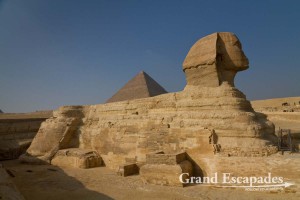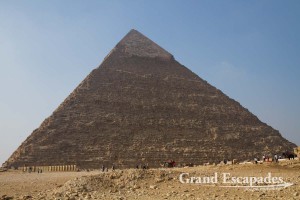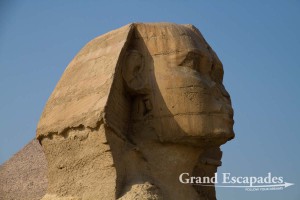Instead of relaxing at least one day in Addis Abeba before heading towards the Omo Valley, we were determined to make the most of our day in Cairo. Even though this stop-over came as a total surprise, we did not have to think twice about what to do there. More challenging was to get a feeling for prices so quickly. We were constantly approached by cab drivers who offered to take us to the Great Pyramids, the Bazaar and the Archaeological Museum. Soon we figured that about 25 Euros was the going rate for newly arrived tourists to be sped to all this sights in one day.
Naturally, our driver stopped on the way to sell us guides who would take us around the Archeological Park in Gizeh on horses, camels, carriage, you name it. They warned us that the area was far too large to be covered on foot, but we did not budge and flat out refused. Needless to say, the three pyramids and the sphinx can be visited in a comfortable stroll.
Actually, it is mostly Egyptian tourists who get on a swaying camel or horse. For the vast majority of foreign visitors this is not an option anyway, because they arrive in large guided groups. So do zillions of Egyptian school children on class outings who were truly excited to see tourists. Many even asked if we would pose for a photo with them. We were surprised to get that much attention at a touristy place like this. But most foreign tourists arrive in tour buses and are driven straight up to the Big Pyramid. So we were among the few non-Egyptians visitors who actually walked the short distance.
What struck us was the incredible simple facility to receive the millions of tourists that arrive at Gizeh. You would expect a large, modern visitor center with an adjacent souvenir shopping mall. Instead a tiny, cube like-building, with shaky, wooden tables welcomes to the last remaining World Wonder.
Similar carefree is the display of priceless historic artifacts at the Archeological Museum. The general impression is that of a giant storage rather than of a world famous museum. The incredibly beautiful, delicately crafted offerings from Tutankhamen’s tomb are carelessly displayed in old, wooden boxes. Often padlocks seem the topmost security measure there is. Tiny pieces of paper, written on mechanic type-writers decades ago, explain treasures more than three thousands years old.
It was shocking and heart-breaking to hear that six weeks after our visit some of the displays were destroyed by the very guardians of the place during the upheaval to get rid of Mubarak.
Cairo’s notorious traffic became the last “highlight” in this city. Painstakingly slow we crawled away from the center. A four lane road is typically occupied by five motorcades, going bumper to bumper. Briefly we tried to picture what it means to be one of the 5 millions commuters that enter and leave the city every day. Well it was beyond our imagination…




No comments yet.